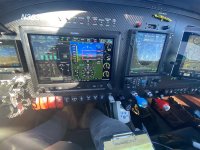First off, I am not suggesting to duplicate my set-up - I like it, but it may not be the route for you...
That caveat aside, if I understand your question/concerns here are a few thoughts from my experience.
For context - I fly about 200 hours a year (RV14) and probably about 20 hours in IMC (i live in the PNW - so, IMC can be hard to avoid half the year).
My panel is in the pic below.
The primary set-up is the GTN/G3x set-up, with slaved A/P (autopilot). Fully legal for IFR/IMC. Works great. There is also remoted a intercom panel, second comm and transponder - but those arent relevent in this discussion. All are accessed by the G3x, and I prefer it this way over having the panel mounted units.
I have a G5 back-up, which should be able to take over Auto/Pilot control if the G3X failed - and, both it and the G3x have a back-up battery. However, if the AP failed, I am hand flying - which can be a load in nasty single pilot IMC. My biggest concern would be if I had a major panel meltdown (fire?) - especially in IMC - and, all the stuff behind the panel was toast.
So....I also run Foreflight slaved to a Sentry (with ADHARS) as a completely separate and redundant system.
The benefits:
>I already have Foreflight and use it. Frankly, cant conceive not having Foreflight - its so useful in so many ways. FF's map on my iPad also generally my primary display for Nav (it also slaves via bluetooth to the G3X and updates routes and flight plans in realtime). The Sentry (via its wi-fi) has its own separate source of NAV info and generates ADAHRS (not showing in my pic, but you can run in split screen mode on the foreflight display to see it - and when in IMC I always run the ipad in split screen with the ADAHRS so I know its operational and there if i need it - I also use it to cross check what my primary G3X screen is showing).
>What I like is that if my panel dies - I have a completely separate/redundant/self-powered system. Both the iPad and the sentry are charging in flight via usb cords - so they are always at full capacity battery-wise. If I lose power, the Ipad is charged and will last more than an hour (maybe two ?), and the sentry has an 8 hour battery. Should be more than enough for me to deal with a situation.
>With this set-up, I can navigate, and shoot an approach if needed in an emergency (albiet, hand flying it). Whist I would lose some of the higher functions of the Garmin, (smart glide, for instance), its still pretty good and lights years ahead of what i relied on a few decades ago.
>In non-emergency situations, I still generally display my approach chart and an overlay on the Foreflight map and use it like a primary reference (even though I display a chart on the G3x, too - but, I aslo find I am toggling between the screen pages on the G3x for other info (airport info, traffic, engine monitor, etc), whereas I keep the chart and map on the Foreflight screen continuously).
So, If I was looking for a basic sytem that was IFR/IMC legal (and useful) - here's what I would have:
Garmin G3x - great primary display (lots of great features - eg. engine monitor, nav, charts, etc)
IFR approved NAV/COM. I am only familitar with the Garmins - but, they have some reletively inexpensive ones. No need for the GTN750.
A/P - if you can afford it, it sure makes flying approaches a lot easier than hand-flying. Its also great for XC flying.
Foreflight
Sentry
iPad mini or larger (these last three are your redundant sytem - have usb power for the sentry and the ipad and charge in flight)
Optional - add a G5
Also, get the battery back-ups for both the G5 and the G3x.
Also, I didnt mention the standard stuff like transponder - there are basic requirement for IFR equipment the FAA has that need to be complied with.
Hope this is useful.


